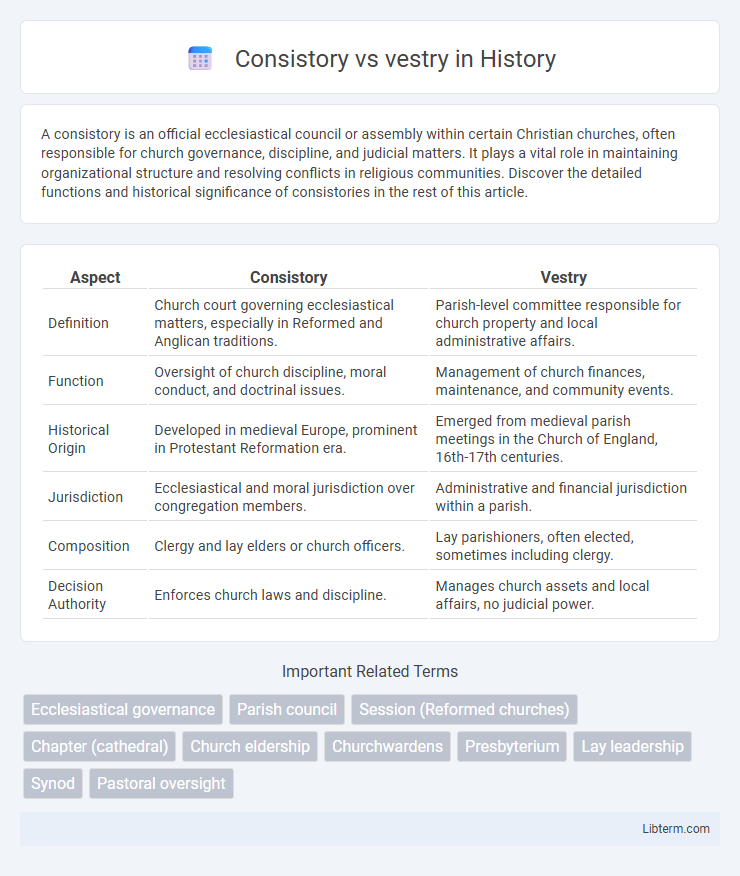A consistory is an official ecclesiastical council or assembly within certain Christian churches, often responsible for church governance, discipline, and judicial matters. It plays a vital role in maintaining organizational structure and resolving conflicts in religious communities. Discover the detailed functions and historical significance of consistories in the rest of this article.
Table of Comparison
| Aspect | Consistory | Vestry |
|---|---|---|
| Definition | Church court governing ecclesiastical matters, especially in Reformed and Anglican traditions. | Parish-level committee responsible for church property and local administrative affairs. |
| Function | Oversight of church discipline, moral conduct, and doctrinal issues. | Management of church finances, maintenance, and community events. |
| Historical Origin | Developed in medieval Europe, prominent in Protestant Reformation era. | Emerged from medieval parish meetings in the Church of England, 16th-17th centuries. |
| Jurisdiction | Ecclesiastical and moral jurisdiction over congregation members. | Administrative and financial jurisdiction within a parish. |
| Composition | Clergy and lay elders or church officers. | Lay parishioners, often elected, sometimes including clergy. |
| Decision Authority | Enforces church laws and discipline. | Manages church assets and local affairs, no judicial power. |
Introduction to Consistory and Vestry
The Consistory is a church court in certain Protestant denominations, responsible for ecclesiastical governance, discipline, and administration within the parish. The Vestry refers to the governing body of an Anglican parish, managing church property, finances, and local affairs. Both institutions play crucial roles in church administration but differ in structure and specific functions across denominations.
Historical Origins of Consistory and Vestry
The consistory originated in medieval Europe as an ecclesiastical court established by the bishop to oversee church discipline and governance within the diocese, primarily in Catholic and Anglican traditions. Vestries emerged from the parish-based governance system in England, initially as meetings held in the church vestry room where local lay members managed parish affairs, including poor relief and church property. Both institutions reflect historical church governance structures but differ in scope, with the consistory focusing on ecclesiastical legal authority and the vestry emphasizing local parish administration.
Definitions and Core Functions
Consistory refers to a governing ecclesiastical body, especially in Reformed churches, responsible for spiritual oversight, church discipline, and pastoral care. Vestry is a committee or council in Anglican or Episcopal churches tasked with managing the temporal affairs, including property maintenance, financial administration, and local parish decisions. Both entities serve essential roles in church governance but differ in scope, with the consistory focusing on spiritual and disciplinary matters, while the vestry handles administrative and fiduciary responsibilities.
Key Structural Differences
Consistories are ecclesiastical governing bodies found primarily in Reformed churches, overseeing doctrinal, disciplinary, and spiritual matters, whereas vestries typically manage the temporal affairs of Anglican or Episcopal parishes, such as property, finances, and parish administration. Consistories often include ministers and elders who make decisions regarding church discipline and worship, while vestries consist of elected lay members focusing on practical church operations. The key structural difference lies in consistory's emphasis on spiritual governance compared to vestry's role in managing physical and financial church resources.
Roles in Church Governance
Consistory and vestry represent distinct governance bodies within various Christian denominations, each with unique roles in church administration. The consistory typically serves as a disciplinary and judicial committee responsible for maintaining doctrinal adherence and church order, often seen in Reformed and Presbyterian traditions. In contrast, the vestry primarily manages the church's financial affairs, property, and lay leadership, a role prevalent in Anglican and Episcopal churches.
Authority and Decision-Making Powers
A consistory typically holds ecclesiastical authority within certain Christian denominations, making decisions on doctrinal, disciplinary, and clerical matters with a focus on church governance and spiritual oversight. In contrast, a vestry functions primarily as a parish-level body responsible for temporal decisions, including financial management, property maintenance, and local administrative tasks within the church community. The consistory's authority often supersedes the vestry's by addressing higher-level church policies, while the vestry exercises decision-making powers limited to practical and operational aspects of parish life.
Denominational Associations
Consistories are predominantly associated with Reformed and Presbyterian churches, serving as ecclesiastical governing bodies overseeing spiritual and administrative matters. Vestries are typically linked with Anglican and Episcopal traditions, functioning as lay committees managing parish affairs and church property. Both bodies reflect denominational distinctions in church governance within Protestant Christianity.
Responsibilities and Duties
Consistory typically refers to a church court or council responsible for disciplinary matters, governance, and overseeing doctrinal adherence within certain Protestant denominations, especially in Reformed churches. The vestry is a local church committee primarily tasked with managing parish finances, property maintenance, and organizing community activities, commonly found in Anglican and Episcopal churches. Both bodies play crucial roles in church administration, with the consistory focusing on spiritual oversight and governance, while the vestry handles temporal and operational responsibilities.
Meeting Procedures and Membership
Consistory meetings are typically governed by church-specific constitutions and involve ordained ministers and elders who hold decision-making authority on doctrinal and disciplinary matters. Vestry meetings, common in Anglican and Episcopal churches, include elected lay members and clergy, focusing on parish governance, property, and finances with decisions made by majority vote following Robert's Rules of Order. Membership in a consistory is usually limited to church officeholders, whereas vestry membership is broader, comprising elected parishioners representing the congregation.
Choosing Between Consistory and Vestry
Choosing between a consistory and a vestry depends largely on the church governance structure and legal traditions of the denomination. A consistory typically refers to a governing body within Reformed churches, responsible for spiritual oversight and church discipline, while a vestry is common in Anglican or Episcopal churches, managing both church property and financial affairs. Understanding these distinctions helps congregations align governance models with theological priorities and administrative needs.
Consistory Infographic

 libterm.com
libterm.com